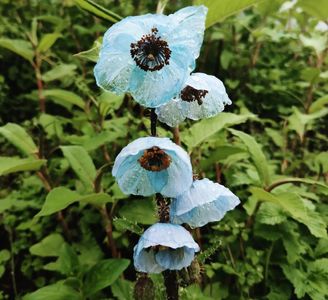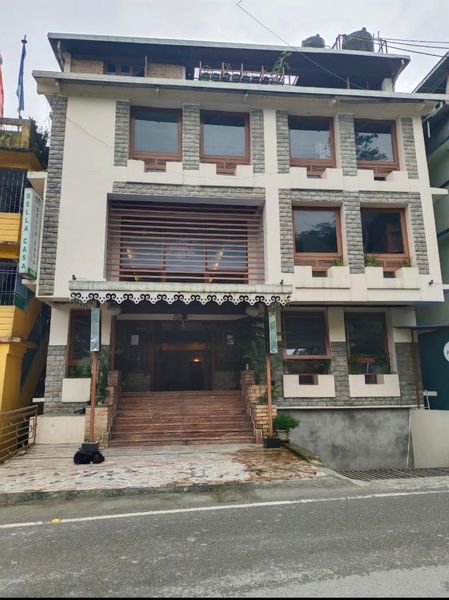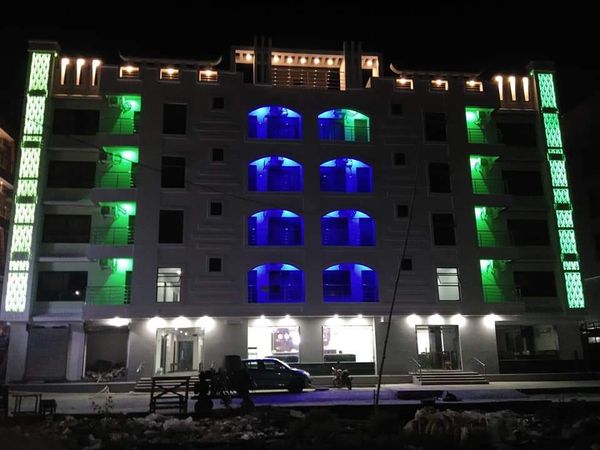Blue Poppy in Valley of Flowers and Beyond: Uttarakhand’s Floral Wonder
 Deepanshu Negi
18 Jul, 2025
9 mins read
105
Deepanshu Negi
18 Jul, 2025
9 mins read
105

The Valley of Flowers in Uttarakhand is a magical place. Every year, during the monsoon season, this valley turns into a living painting filled with colors. One of the most rare and beautiful flowers that bloom here is the Blue Poppy, also known as Meconopsis aculeata. It is a high-altitude flower that attracts nature lovers, botanists, photographers, and trekkers from all around the world. This article takes you through everything you need to know about the Blue Poppy, its home in the Valley of Flowers, and why it holds such importance.
Personal Experience in the Valley of Flowers
Many visitors who have trekked to the Valley of Flowers describe the experience as life-changing. The moment you step into the valley, you are welcomed by a carpet of wildflowers. The fresh mountain air, the sound of birds, and the cool breeze make it feel like heaven on Earth.
The Blue Poppy is often seen growing on rocky slopes and hidden corners of the valley. Spotting it is like finding a hidden gem. Its bright blue color stands out against the green and white landscape. Trekkers often feel lucky and proud to capture a picture of this flower in its natural habitat.
People who have seen the Blue Poppy in full bloom often say that no photograph can do justice to its beauty. The combination of high-altitude mist and early morning light makes the flower look like it is glowing. Those who visit often return with stories of peace and joy, deeply moved by nature’s quiet charm.
What Makes the Blue Poppy Special
The Blue Poppy is not just another flower. It is one of the rarest and most delicate flowers found in the Himalayan region. It usually blooms between July and early September. What makes it truly special is that it grows only in high altitudes, usually above 3000 meters. This makes it hard to find and even harder to protect.
Unlike common flowers, the Blue Poppy requires a very specific environment to grow. It needs cool temperatures, clean air, moist soil, and limited human interference. That is why the Valley of Flowers is such a perfect home for it. The area is part of a national park and is protected by law, which helps in keeping the flower safe.
Botanical Facts and Importance
The Blue Poppy belongs to the Papaveraceae family. Scientifically, it is called Meconopsis aculeata. The flower has a soft and fragile look but is well-adapted to the harsh climate of the Himalayas. Its petals are large, usually sky blue or violet-blue, with a bright yellow center.
The Blue Poppy is also known for its medicinal value. In traditional Tibetan and Ayurvedic medicine, parts of the plant are used to treat several conditions, including inflammation and pain. However, due to its rarity, overharvesting has become a serious issue. It is now classified as endangered in many parts of its natural range.
The Valley of Flowers as a Biodiversity Hotspot
Located in the Chamoli district of Uttarakhand, the Valley of Flowers is part of the Nanda Devi Biosphere Reserve. It was declared a UNESCO World Heritage Site in 2005. The valley is open to visitors only from June to October. During this time, over 500 species of flowers bloom, making it one of the richest floral regions in the country.
The Valley is not only home to the Blue Poppy but also to other rare plants like Brahma Kamal, Cobra Lily, and Himalayan Bellflower. It is also a sanctuary for endangered animals such as the Asiatic black bear, snow leopard, musk deer, and Himalayan monal.
This delicate ecosystem plays an important role in maintaining the region’s environmental balance. It protects water sources, supports local wildlife, and helps in controlling the climate.
Responsible Travel and Sustainable Tourism
Due to the increasing number of tourists, the Valley of Flowers is facing some challenges. More visitors mean more waste, more foot traffic, and more pressure on the fragile ecosystem. That is why responsible tourism is very important. Visitors are advised to stick to marked paths, avoid picking flowers, and carry all waste back with them.
Eco-friendly trekking practices such as avoiding plastic, using biodegradable products, and respecting local customs can go a long way in preserving the valley for future generations. Several local guides and trekking companies now follow green policies to minimize their impact on the environment.
By choosing responsible travel options, visitors can enjoy the beauty of the valley without causing harm to it. In return, they get an authentic and meaningful experience.
Role of Local Communities and Conservation Efforts
The local communities living near the Valley of Flowers play a key role in its protection. Many of them serve as guides, porters, and caretakers of the park. Their knowledge of the land and its biodiversity is passed down through generations.
Government agencies and environmental groups have also taken steps to protect the Blue Poppy and other native plants. Awareness programs, plant nurseries, and research studies are being carried out to ensure that the flowers continue to bloom every year.
Schools in nearby villages are teaching children about the value of nature conservation. This combined effort is slowly building a future where nature and people can coexist in harmony.
Beyond the Valley of Flowers
Though the Valley of Flowers is the most famous spot to see the Blue Poppy, it can also be found in other parts of Uttarakhand and the Indian Himalayas. Places like Kedarnath Wildlife Sanctuary and parts of the Kumaon region have reported sightings of the flower. However, access to these areas is more limited, and the flowers are harder to find due to rough terrain.
For those who cannot trek to the Valley of Flowers, botanical gardens in the region sometimes grow Blue Poppies in controlled conditions. While these cannot match the beauty of the wild version, they still offer a chance to witness this floral wonder.
Conclusion
The Blue Poppy is more than just a flower. It is a symbol of nature’s grace and the delicate balance that keeps our planet alive. Its rare beauty, deep cultural roots, and ecological value make it one of the most treasured plants in India. The Valley of Flowers, its natural home, is a living example of what can be achieved when people and nature work together.
By understanding, respecting, and protecting the Blue Poppy, we take a small but important step toward preserving our natural heritage. Whether you are a traveler, a student, or someone who simply loves nature, the story of the Blue Poppy is sure to leave a lasting impression on your heart.
Written By:
Deepanshu Negi



Hotels at your convenience
Now choose your stay according to your preference. From finding a place for your dream destination or a mere weekend getaway to business accommodations or brief stay, we have got you covered. Explore hotels as per your mood.


